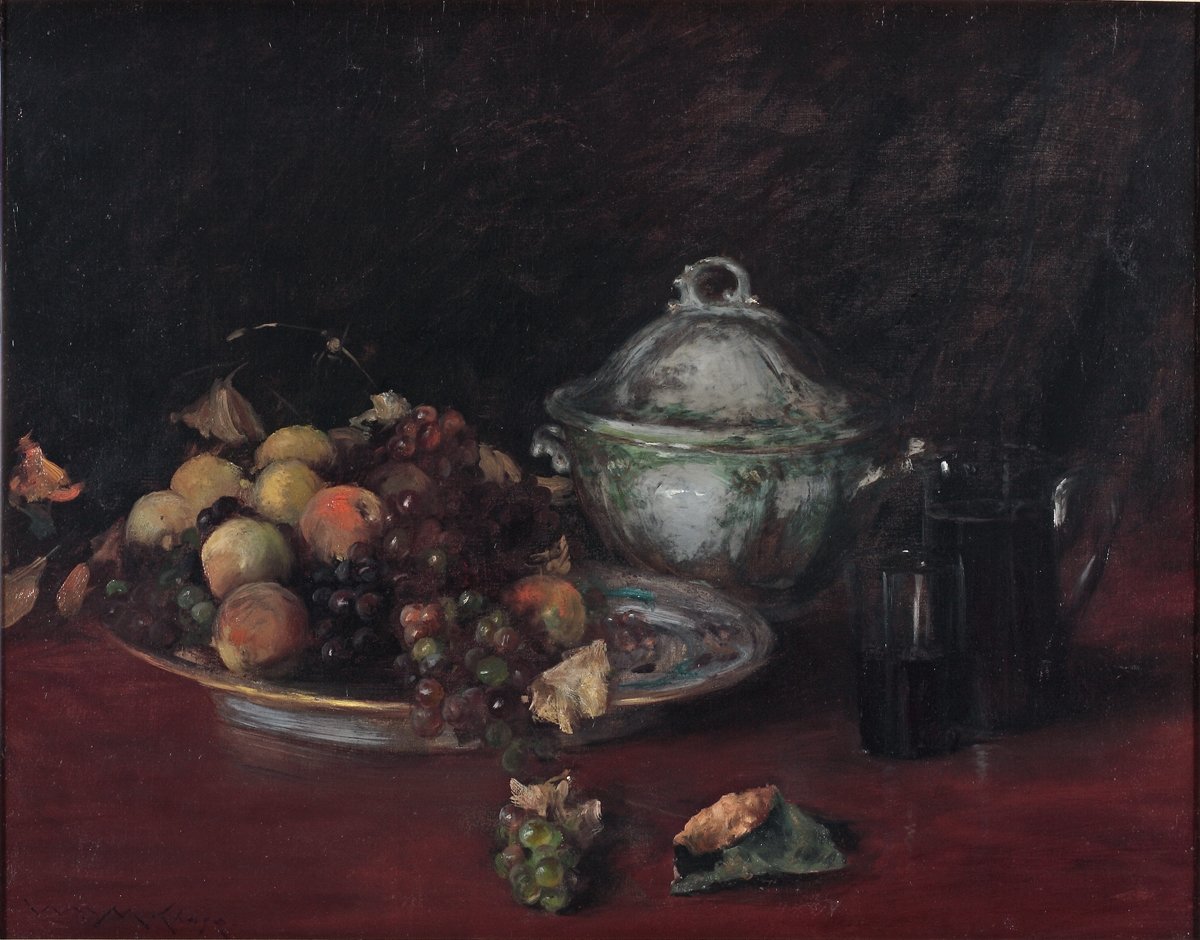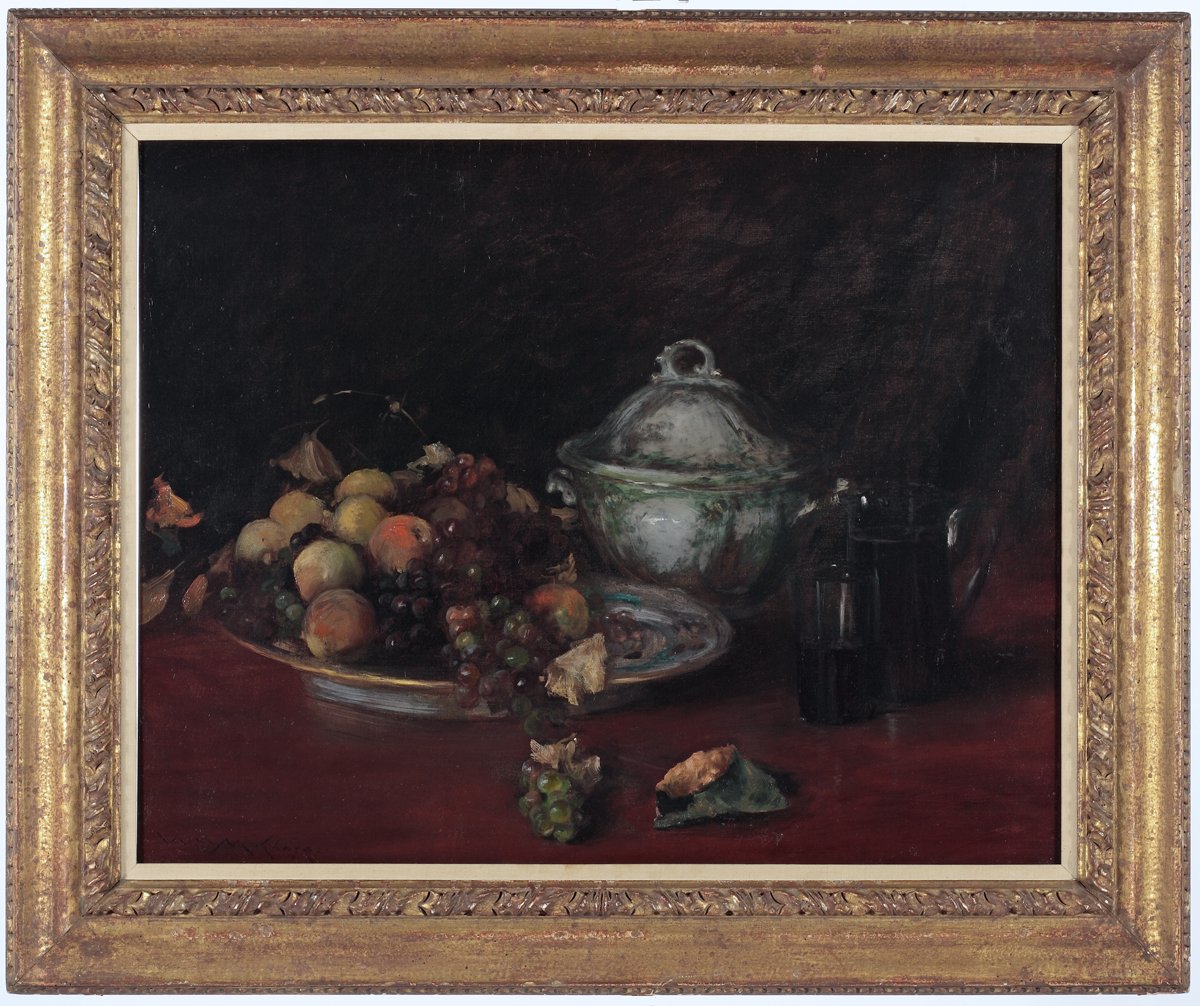Paintings
William Merrit Chase
American, 1849-1916Fruit and Porcelain
Oil on canvas29 x 36 in. (73.6 x 91.4 cm), W/frame 38 by 45 in.
Signed "Wm M Chase." l.l., identified on labels from the Corcoran Gallery of Art,
Provenance:
Exhibitions: Summer’s Lease, Corcoran Gallery of Art, June 13 to August 31, 1972, Ex-collection of Mr. and Mrs. Joseph H. Hennage; William Merritt Chase Memorial Exhibition, The Metropolitan Museum of Art, New York, February 19 to March 18, 1917, No. 30 (lent by Content Johnson); Exhibition of Paintings by William Merritt Chase, National Arts Club, New York, January 5 to 13, 1910, No. 86 (lent by Content Johnson).
N.B. We wish to thank D. Frederick Baker for confirming the authenticity of the present work, and for his assistance with cataloguing the lot. The work is included in Ronald G. Pisano’s The Complete Catalogue of Known and Documented Work by William Merritt Chase (1849-1916), Vol. 4 (Yale University Press, 2010, SL.127). According to Baker, “the work was either purchased by Content Aline Johnson from Chase, or more likely given by the artist to Johnson, a student of Chase’s and close friend of the Chase family. Chase’s youngest daughter, Mary Content Johnson, born 1903, was named after Content Johnson. The painting is one of several by Chase that were owned by Miss Johnson, whose portrait was painted by Chase, ca. 1902.”
Inventory Number: Art C59See Artist Bio below.
William Merrit Chase
American, 1849-1916William Merritt Chase was born in 1849 in Williamsburg, Indiana, the oldest child of a successful merchant. In 1861, the Chase family moved to the rapidly growing city of Indianapolis, where Chase received his first artistic training under a local painter, Barton S. Hays. On Hays’ advice, Chase went to New York for further training at the National Academy of Design.
In 1871, Chase moved to Saint Louis, where his family had relocated. There he established himself as a still-life painter, but had little success. His fortunes changed when he was befriended by two prominent local businessmen who financed his study at the Munich Royal Academy under Karl von Piloty. Piloty stressed a tenebrous, bravura style derived largely from the Dutch and Spanish masters of the seventeenth century. In Munich, Chase also joined forces with the “Duveneck Boys,” a lively group of artists whose mentor was Frank Duveneck.
Chase’s reputation as a painter preceded his return to New York in 1878. A teaching position also awaited him, the first in a long career, at the newly established Art Students League. In l878, he acquired the former studio of Albert Bierstadt in the famous Tenth Street Studio Building, which had earlier been known for its contingent of Hudson River painters. Adorned with paintings, tapestries, objects of art and bric-a-brac that Chase collected voraciously, the studio became a gathering place for artists, students and patrons, and the showcase for Chase himself.
In the 1880s, Chase came to realize the limitations of the dark palette of Munich, as he became more and more interested in landscape painting and in the possibilities of pastels. He began to paint plein-air scenes such as “A Subtle Device” 1881 (Private Collection) in which he portrayed himself sketching directly outdoors.
Three trips to Europe followed—-in 1881 and 1882 to Spain and France and in 1884 to Holland. In the mid-l880s, Chase applied what he had learned from his experiments in the use of color in Holland to the American landscape. In his simple atmospheric renditions of the Brooklyn countryside and of Prospect and Central Parks, he drew attention to the inherent beauty of his own country.
These scenes of leisurely life in restful settings are paralleled in mood by the domestic interiors that Chase began to create after his marriage to Alice Gerson in 1886 and the growth of his family in the years that followed.
In 1882, Chase helped found the Society of American Painters in Pastel and created an extraordinary body of work in this medium. From 189l to 1902, he conducted classes in the open-air at Shinnecock Hills, Long Island, and it was during this period that some of his most celebrated works were painted, such as “The Fairy Tale,” 1892 (Collection of Mr. and Mrs. Raymond J. Horowitz) and “The Friendly Call,” 1895 (National Gallery of Art, Washington, D.C.).
In these Impressionist paintings, Chase explored effects of light and atmosphere on the grassy dunes along the coast and celebrated the open spaces surrounding his summer home.
At the close of his Shinnecock School in 1902, Chase began organizing formal summer teaching trips abroad—-to Madrid, Florence, Bruges, Venice, and Haarlem. Although he completed a number of landscapes during these European tours, his major effort in the twentieth century was devoted to the painting of still life and portraits.
In l903, Chase was elected a member of The Ten, the association of prominent New York and Boston Impressionists. Chase replaced John Henry Twachtman who had died the previous year. In the last decade of his career, Chase received high accolades for his art and was given one-man shows in nearly every important city in the country.
Chase’s students numbered in the thousands; among the better known were Gifford Beal, Guy Péne du Bois, Charles Demuth, Marsden Hartley, Edward Hopper, Alfred Maurer, Kenneth Hayes Miller, Georgia O’Keeffe and Charles Sheeler.



